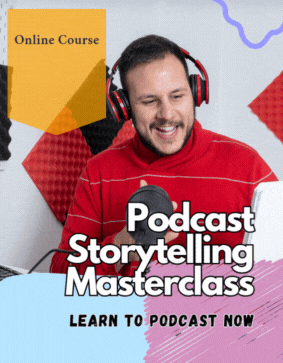7 tips for conducting better podcast interviews
42,241 View
Share this Video
- Publish Date:
- June 8, 2025
- Category:
- Learn to Podcast
- Video License
- Standard License
- Imported From:
- Youtube
Tags
When you have a great interview, it's going to sound like an effortless conversation. You're interested in what your guest has to say, your guest is interested in what you have to say, and everything just flows.
So in this episode we'll share seven tips on how to conduct great podcast interviews and give your audience something worth listening to.
🎧 Podcasts with great interviewers
✅ "Sway" with Kara Swisher - https://www.nytimes.com/column/sway
✅ "Creating a Brand" with Alex Sanfilippo - https://creatingabrand.com/listen/
✅ "The School of Greatness" with Lewis Howes - https://lewishowes.com/podcast/
✅ "The Jordan Harbinger Show" - https://www.jordanharbinger.com/podcasts/
🤷♀️ Having trouble finding quality guests for your podcast?
Try PodMatch, a service which uses A.I. to painlessly match ideal podcast guests and hosts together to produce high quality interviews.
✅ https://podmatch.com/signup/buzzsprout
🎙 Record your podcasting question at https://www.speakpipe.com/buzzsprout to be featured on a future episode.
Review Podcasting Q&A in Podchaser to let us know what you think of the show
✅ https://www.podchaser.com/podcasts/podcasting-qa-859980
==== Time Stamps ====
00:00 - Introduction
00:32 - #1. Choosing guests
01:17 - #2. Do your research
02:04 - #3. Active Listening
02:40 - #4. Clear and direct
03:07 - #5. Listen to interviews
03:37 - #6. Grade yourself
03:56 - Alex Sanfilippo
===================
INTERESTED IN STARTING A PODCAST?
Watch our "How to Start a Podcast in 2021" video to get up and running in no time: https://youtu.be/TiPAto5QIkE
Start your podcast for free with Buzzsprout at https://bit.ly/2pGU2ux
-----------------------------------------
Podcast in The Classroom - Kindergarten to High School
Looking for a fun and engaging way to teach students? Podcasting in the Classroom is an incredible tool that brings multimedia learning to life! Whether you're teaching Kindergarten or High School, this course will show you how to use podcasts to enhance learning, engage students, and even involve parents.
In this course, you’ll learn how to:
✅ Use podcasts as an interactive tool to engage your students
✅ Teach students how to create their own podcasts
✅ Keep parents and students up-to-date with podcast updates
✅ Review and improve teaching performance through podcasts
✅ Overcome common challenges like copyright and privacy concerns
With over one billion podcast subscribers worldwide, your students are likely already listening to podcasts — now, let them create their own! 📚
👉 Click here to enroll now and take your teaching to the next level with podcasts.
Make learning more interactive and fun — let's get podcasting in the classroom! 🎤
3 Must-Know Podcasting Tips for Your Show
Integrating Music and Sound Effects Appropriately

Music and sound effects can significantly enhance the quality and appeal of your podcast when used appropriately. Select intro and outro music that reflects the tone and theme of your show, creating a consistent auditory brand identity. Use background music sparingly during episodes to complement the conversation without overpowering it. Incorporate sound effects to emphasize key points, transitions, or humorous elements, adding a dynamic layer to your content. Ensure that all audio elements are balanced and do not distract from the primary audio, maintaining a professional and polished sound. Thoughtful integration of music and effects can make your podcast more engaging and enjoyable for your listeners.
Promoting Your Podcast on Social Media

Utilizing social media is a powerful way to promote your podcast and reach a broader audience. Identify the platforms where your target listeners are most active, such as Twitter, Instagram, Facebook, or LinkedIn. Create engaging posts that highlight episode highlights, guest appearances, and behind-the-scenes content. Use relevant hashtags to increase visibility and join conversations related to your podcast’s niche. Share audio clips or short video snippets to give potential listeners a taste of your content. Encourage your audience to share episodes with their networks, and interact with followers by responding to comments and messages. A strategic social media presence can significantly enhance your podcast’s reach and listener engagement.
Ensuring Legal Compliance in Your Podcast

Maintaining legal compliance is essential to protect your podcast and its content from potential issues. Secure the necessary rights and licenses for any music, sound effects, or third-party content you use in your episodes to avoid copyright infringement. Obtain permission from guests to record and distribute their contributions, and consider having them sign release forms to formalize their consent. Be mindful of privacy laws by respecting the confidentiality and personal information of your listeners and participants. Additionally, adhere to advertising regulations when incorporating sponsorships or affiliate marketing, clearly disclosing any paid partnerships. Staying informed about relevant laws and regulations ensures that your podcast operates smoothly and mitigates legal risks.
Frequently Asked Questions
What is the role of a podcast publisher?
A podcast publisher manages the dissemination of your episodes to various platforms, handles distribution logistics, and often provides tools for analytics and monetization to support your show’s growth.
How long should a typical podcast episode be?
Episode length can vary, but typically ranges from 20 to 60 minutes. Choose a duration that suits your content and keeps your audience engaged without overwhelming them.
What should I include in my podcast's intro and outro?
Your intro should introduce the podcast and set the tone, while the outro can include a summary, thank you message, and a call to action, such as subscribing or following on social media.
What role do podcast covers and branding play?
Visual elements like podcast covers and branding are crucial for making a strong first impression, attracting potential listeners, and conveying the essence of your show effectively.
What legal considerations should I be aware of in podcasting?
Ensure you have rights to any music or content used, obtain necessary permissions for guest appearances, and adhere to copyright laws. Consider including disclaimers and privacy policies as needed.
What is the best way to prepare for a podcast interview?
Research your guest thoroughly, prepare insightful questions, test your equipment beforehand, and create a comfortable environment to facilitate a natural and engaging conversation.
Statistics
- About 60% of podcasters find that offering premium content subscriptions generates additional revenue.
- Guest appearances on podcasts can result in a 15% increase in subscriber numbers.
- Podcasts that utilize analytics to refine content strategies experience a 40% improvement in listener satisfaction.
- On average, podcasters spend about 10 hours per episode from planning to publishing.
- Podcasts that include detailed show notes experience a 50% increase in listener engagement.
- Collaborating with other podcasters can lead to a 20% growth in listener base.
- Investing in professional editing services can enhance the overall quality of a podcast, leading to a 30% increase in positive feedback.
- Using transcription services can make podcasts accessible to a wider audience, increasing reach by up to 25%.
- Genres such as true crime, technology, and personal development are among the most popular, attracting over 70% of listeners.
- Podcasts utilizing video snippets on social media experience a 20% rise in audience interaction.
- Podcasts with interactive segments, such as Q&A sessions, see a 25% boost in audience participation.
- Listener reviews and ratings contribute to a 25% increase in podcast discoverability.
- Listeners are 50% more likely to subscribe to podcasts that offer regular episode releases.
- Podcasts that engage with their audience through email newsletters see a 30% higher retention rate.
- Engaging storytelling techniques can increase listener retention rates by up to 50%.
- Effective use of keywords in podcast descriptions can improve search rankings by 30%.
External Links
shutterstock.com
help.apple.com
socialmediaexaminer.com
anchor.fm
podcastmovement.com
buzzsprout.com
thepodcasthost.com
hootsuite.com
podcastitalia.com
canva.com
zoom.us
podcastpage.io
optimizingpodcasting.com
podcasters.spotify.com
podcastcareers.com
podcastinsights.com
patreon.com
How To
How To Utilize Podcast Directories to Expand Reach
Listing your podcast on various directories increases its visibility and accessibility to a broader audience. Start by submitting your podcast to major directories such as Apple Podcasts, Spotify, Google Podcasts, and Stitcher, ensuring you follow each platform’s submission guidelines. Optimize your podcast’s metadata, including titles, descriptions, and keywords, to enhance discoverability through search functions within these directories. Encourage listeners to subscribe and leave reviews, as positive ratings can improve your ranking and attract new listeners. Regularly update your podcast on these platforms to keep the content fresh and maintain your audience’s interest. Expanding your presence across multiple directories ensures that your podcast reaches listeners wherever they prefer to access their audio content.















